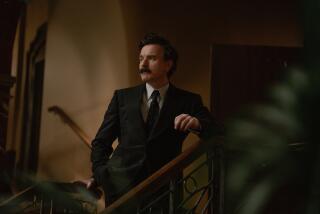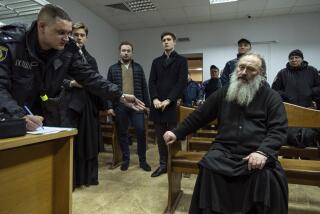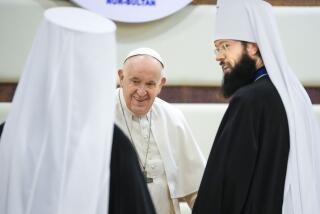Reagan Turns Monastery Into Symbol of Visit
MOSCOW — As bells pealed and monks sang, President Reagan paid an unlikely visit Monday, turning a 700-year-old Russian Orthodox monastery into the very symbol of his personal campaign to pressure the Soviet Union into allowing greater freedom of religion.
Reagan brought an entourage of some of the most senior officials of the U.S. government, along with television cameras and reporters, to the Danilov Monastery. Until five years ago, the monastery had served as a prison and a bicycle factory, among other things, in the years following the 1917 Bolshevik Revolution, a period in which the practice of religion brought sharp persecution.
‘New Chorus of Belief’
Using the visit to prod Soviet leader Mikhail S. Gorbachev to continue his twin policies of glasnost, or openness, and perestroika, or restructuring, Reagan told a specially selected group of about 10 monks:
“We don’t know if this first thaw will be followed by a resurgent spring of religious liberty--we don’t know, but we may hope. We may hope that perestroika will be accompanied by a deeper restructuring, a deeper conversion, a mentanoya-- a change in heart--and that glasnost, which means giving voice, will also let loose a new chorus of belief, a singing praise to the God that gave us life.”
The visit was not without controversy, not only in Moscow but also in the United States, where critics complained that the Russian Orthodox Church in the Soviet Union is too closely aligned with the state--particularly the internal security apparatus of the KGB--to represent a proper symbol for the President’s message.
And in Moscow, White House officials had complained of a lack of Soviet cooperation in helping arrange the visit, nearly up to the time of the President’s arrival.
A Political Foundation
Although Gorbachev recently took the unprecedented step of meeting with the church’s highest officials, supporters of church dissidents contend that the thaw has a political foundation. Gorbachev, they say, needs the support of a variety of Soviet institutions to broaden the base of support for the breadth of reforms he seeks to impose.
Similarly, a White House official has said that the church visit reflected an element of domestic politics for the President too.
“We’re doing some of these things on religous freedom because part of the President’s core of support” comes from conservative religious groups, said the official, who spoke on the condition of anonymity.
Under the dark green turrets and gold onion-shaped domes of the white-walled monastery, Reagan visited a sparsely decorated room where he and First Lady Nancy Reagan viewed the restoration of Russian Orthodox icons. The painstaking task takes two to three weeks of full-time work for each of the detailed, painted images that play a central role in Orthodox worship.
‘Tested and Tempered’
“One cannot look at the magnificent icons created and re-created here . . . without experiencing the deep faith that lives in the hearts of the people of this land,” said Reagan, who was accompanied on the visit by Secretary of State George P. Shultz and National Security Adviser Colin L. Powell, among others.
The President said the faith of the Soviet people, like the saints and martyrs depicted in the icons, “has been tested and tempered in the crucible of hardship.”
“But in that suffering, it has grown strong, ready now to embrace with new hope the beginnings of a second Christian millennium,” he said, adding:
“We in our country share this hope for a new age of religious freedom in the Soviet Union. We share the hope that this monastery is not an end in itself, but the symbol of a new policy of religious tolerance that will extend to all peoples of all faiths.”
Reagan said he prayed that the monastery’s return to the organized church “signals a willingness to return to believers the thousands of other houses of worship which are now closed, boarded up or used for secular purposes.”
‘The Pacifying Countryside’
The President quoted from a passage by dissident writer Alexander Solzhenitzyn, living in exile in Vermont, who wrote that “it is in the churches” that one can “begin to understand the secret of the pacifying Russian countryside.”
Before Reagan arrived at the church, there was little in the way of pacification. Indeed, a verbal fracas erupted between Soviet and White House officials over access to the meeting by a small group of American reporters and camera crews.
“Do you want to tell me that the American press can’t cover the American President?” Gary Foster, a White House advance man, asked a Soviet official.
The Soviets relented only after Foster said that if the Soviets persisted, there would be “no Soviet coverage” of any of Reagan’s meetings with Soviet citizens at Spaso House, the U.S. ambassador’s residence here.
Arrival of Christianity
Reagan’s focus on the role of the church in the Soviet Union coincides with the 1,000th anniversary, being celebrated June 4-16, of the mass baptism in the year 988 of the subjects of Prince Vladimir in the Dnieper River near Kiev. The event traditionally is accepted as marking the arrival of Christianity in Russia.
With the anniversary approaching, Gorbachev met April 29 with Patriarch Pimen, the head of the Russian Orthodox Church, and acknowledged that mistakes had been made in the treatment of religious believers. He also announced that his government was drawing up a law on freedom of conscience.
“The believers are Soviet people, workers, patriots, and they have the full right to express their conviction with dignity,” Gorbachev said in the Kremlin meeting, which was shown on Soviet television’s widely viewed evening news program.
Shift in Official View
His comments that day marked a stunning shift in the official view of religion in this vast nation, which had for more than two decades tolerated the Russian Orthodox Church on a small scale but had discouraged citizens from straying from the Communist Party’s official policy of atheism.
Still, said Albert Boiter, editor of the quarterly magazine Religion in Communist-Dominated Lands and a director of the Institute for the Study of Religion and Human Rights in Closed Societies, the shifts “don’t amount to a great deal of change in attitudes toward religion. But they do reflect a change in the right of the individual to be a believer in Soviet society.”
More to Read
Sign up for Essential California
The most important California stories and recommendations in your inbox every morning.
You may occasionally receive promotional content from the Los Angeles Times.










